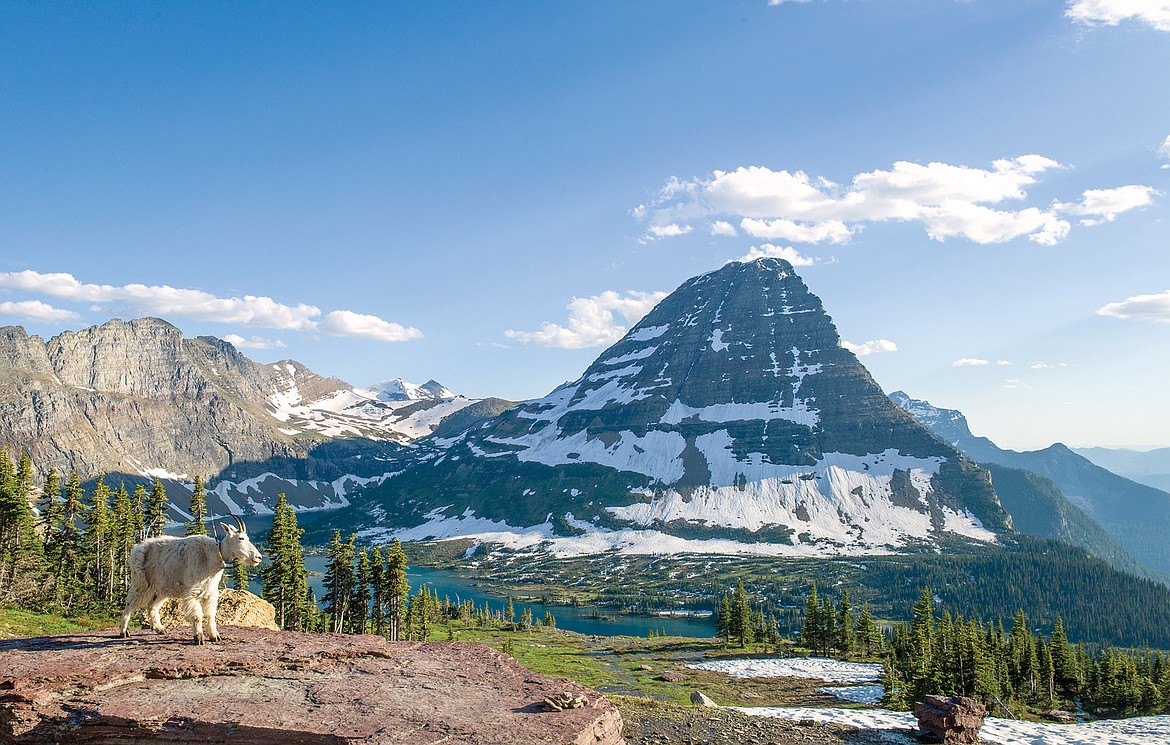In Glacier Park, snowfields help mountain goats breathe easy
CHRIS PETERSON | Hagadone News Network | UPDATED 4 years, 11 months AGO
Chris Peterson is the editor of the Hungry Horse News. He covers Columbia Falls, the Canyon, Glacier National Park and the Bob Marshall Wilderness. All told, about 4 million acres of the best parts of the planet. He can be reached at [email protected] or 406-892-2151. | January 20, 2021 12:00 AM
Coronavirus notwithstanding, a study of Glacier National Park’s mountain goats continued last summer.
Tracking the goats doesn’t always require fieldwork. They have GPS collars on, which transmit a signal right back to a server. A biologist can see where they are with a few clicks of a mouse.
But when they die, well, that’s another thing. Researchers try to retrieve the collars and determine the cause of death, notes Mark Biel, Glacier National Park natural resource manager.
The goat study, now entering its third year, is looking at populations dynamics and the potential impacts of climate change on the iconic creatures.
Last year’s data has reaffirmed what was previously known about some of Glacier’s goat populations.
For one, populations that are close to one another don’t intermingle much. For example, goats that live at Logan Pass
don’t really mingle with goats at Sperry Chalet and Gunsight Pass.
Even the mountain goats at Gunsight and Lake Ellen Wilson don’t mix with the ones at Sperry, which is just a short distance away.
There are exceptions, however. Biel noted one male seems to visit them all, and likely, mates with the otherwise sepa- rate populations.
And goats will travel long distances, not to be social, but for salt — mineral licks to be precise. Goats that were first collared at the Goat Lick in the southern end of the park traveled all the way from Great Northern Mountain.
The Goat Lick has natural minerals in the soil in the cliffs of the Middle Fork of the Flathead that goats crave in the spring and early summer. Goats from Great Northern are traveling more than 14 miles to get to the lick, through forested terrain.
Sometimes the journey means the end of them. One goat was killed by a predator in the woods near Sheep Creek.
But while goats are willing to travel through the trees to get to mineral licks, they much prefer open terrain, cliffs and snowfields.
A previous study by Wesley Sarmento, Joel Berger and Biel found that goats near Logan Pass showed an affinity for snowfields on hot summer days. Mountain goats’ respiration rates when near snow dropped about 15%, as the snow cooled their bodies.
“Selection for snow was so influential that the odds of mountain goat use of an area decreased 68% for every one kilometer (.62 miles) further from snow patches — which was greater than their famous selection for escape terrain,” the study found.
Escape terrain, in the context of mountain goats, is cliffs — the steeper the better.
But the authors note there are introduced populations of goats in other regions, like the Black Hills of South Dakota, where goats are surviving without summer snowfields, at least for now. They also note there used to be a population of mountain goats in the Grand Canyon, but they went extinct about 11,000 years ago.
But snow doesn’t just keep goats cool, it also keeps trees from growing. Glacier has become more and more forested over the past 100 years studies have found. Goats are not a forest animal. They typically feed in open high alpine meadows, not in the trees. Trees fragment meadow habitat and also make it easier for predators to hide.
Of the 24 goats that have been collared over the course of this study, five have died. Some were natural causes, some were undetermined, but two or three were killed by predators.
“Most likely by a bear,” Biel noted.
Grizzly bears have often been seen in Glacier chasing and killing goats.
The study has also revealed just how sharp a mountain goat’s horns are.
At the Goat Lick, one younger male goat, about two or three years old, approached a nanny and the nanny swung its horns at it in an aggressive manner. The nanny made contact with the younger goat and killed it. The horns had punctured the young male’s jugular vein, a necropsy later showed, Biel said.
This current goat study is expected to end this year, it may extend another year if funding is available. The Glacier National Park Conservancy supported this project.
ARTICLES BY CHRIS PETERSON

Columbia Falls School District makes pitch for charter school
Columbia Falls School District Superintendent Cory Dziowgo and staff recently made a pitch to the Montana Board of Public Education for a new Columbia Falls Trades Academy.

Columbia Falls concerned sewer system could be bottleneck for growth
The City of Columbia Falls could see a significant bottleneck in future growth due to its sewage treatment plant, depending how the city and the state calculate the sewage treatment plant’s maximum treatment capacity without a major upgrade.
Columbia Falls City Council tables e-bike law
The Columbia Falls City Council last week voted to table a city ordinance that would restrict e-bikes and e-motorcycles along with other electrically powered vehicles on its sidewalks and city parks.

